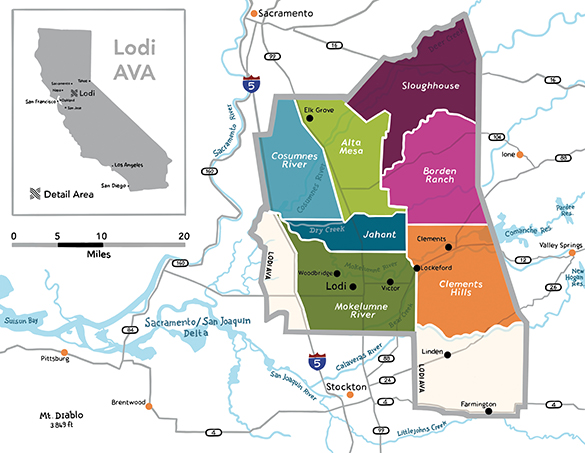Mokelumne River
The largest of Lodi’s sub-AVAs with approximately 42,000 acres out of the 85,700 acres planted to a diverse variety of winegrapes. The AVA is named for the Mokelumne (or Mighty Moke) – a 95-mile-long river flowing from the central Sierra Nevada through Lodi and the Sacramento-San Joaquin Delta before emptying into the San Joaquin River-Stockton Deep Water Shipping Chanel. One of the most distinguishing characteristics is the soil. Deep sandy loam Tokay and Acampo soils dominate the area, allowing for ideal drainage, vine health, and naturally moderated grape yields.
Jahant
The smallest of Lodi’s sub-AVAs with approximately 9,000 out of 28,000 acres planted to winegrapes. The name is derived from Peter Jahant who settled in the vicinity of the small, neighboring town of Acampo in the 1850s. Two of the most distinguishing characteristics are its pinkish Rocklin-Jahant loam soils. The soils are so unique that the boundaries of the Jahant AVA are defined by their extent. These soils tend to be sandier at the top and are preceded by layers of dense, cemented clay and gravel. While these thick layers make it more difficult for a grapevine to establish exceptionally deep roots, they also retain water well which means less need for irrigation.
Cosumnes River
The largest of Lodi’s sub-AVAs in terms of total acreage, 54,700, but only contains 3,500 planted acres making it the smallest number out of all seven sub-AVAs. The AVA is named for the Cosumnes – a river that flows out from the Sierra Nevada and down through the north eastern portion of the Lodi AVA before joining the Mokelumne River at Cosumnes AVA’s southwest corner. Younger, moderately fertile, silty soils dominate 60% of the AVA in lower areas of floodplains, sloughs, and wetlands. The remaining 40% is covered with mid-age, reddish, gravelly clay loam soils in the San Joaquin Series.

